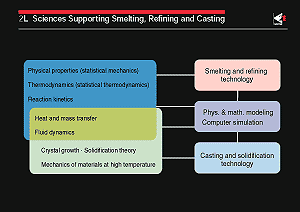In summary, the smelting, refining,
and casting of iron and steel are the processes for extracting
iron from ore, removing useless and harmful elements and adding
necessary elements, and obtaining clean and homogeneous materials
of required shape, respectively. These results are achieved by
making use of chemical reactions among the substances involved.
The scientific principles that deal with chemical reactions are
those of thermodynamics and reaction kinetics. The former deals
with the direction in which a reaction proceeds and reaches the
equilibrium state, and the latter considers the mechanism and
rate of the reaction to reach the equilibrium. A prerequisite
for the application of these principles is that the structure
of the substances participating in the reactions and the values
of physical properties based on their structure should be known
in as much detail as possible. For better understanding, it is
necessary to have a knowledge of statistical mechanics and statistical
thermodynamics.
The most important feature of the smelting, refining, and casting
processes for iron and steel is their ability to handle large
amounts of liquid materials such as hot metal, molten steel,
and molten slag. Consequently, it is imperative to have a thorough
knowledge of the scientific principles underlying the transfer
of heat, momentum, and mass, and the movement of fluids at elevated
temperatures.
Good castings without segregation of solute elements or cracks
can be achieved by studying (i) the nucleation, growth and phase
transformation of crystals growing from molten steel, (ii) associated
heat transfer, and stress and strain in the crystals, (iii) changes
in the concentration of the solute elements, and (iv) the mechanical
behavior of materials at elevated temperatures.
Advances in computer technology enable desk experiments by combining
physical and mathematical models with computer simulation. Recent
progress in this approach includes analysis and design of iron
and steel manufacturing processes and construction of phase diagrams
for designing new alloys. As the data base for this area of
science and technology accumulates and our understanding on the
processes improves, this approach will further develop to enhance
the progress of the processing of iron and steelmaking.
Further progress in all of these related studies is required
to ensure that smelting, refining, and casting techniques continue
to improve in the future. |
|
 |
 |
 |
|
|